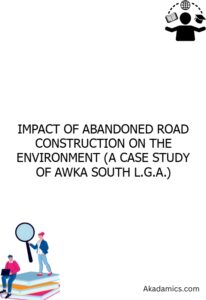
ENTREPRENEURIAL STUDYING OF A GOAT IN PRODUCTION IN IDEATO SOUTH L.G.A
in Research Project Paper , Studies & Thesis on November 5, 2024Choose Your Desired Option(s)
Share Now!
ABSTRACT
This study is entrepreneurial studying of a goat in production in ideato south l.g.ausing primary data from 18 commercial goat farms in different states. It has been revealed that several large and progressive farmers, businessman and industrialists have adopted commercial goat farming. The entry of large farmers, who have better access to technical knowledge, resources and market, into this activity would help in realizing the potential of goat enterprise. A majority of commercial goat farms have been found operating with positive net returns. Goat rearing has been found equally rewarding under both intensive and semi-intensive systems of management. Intensification and commercialisation of goat enterprise has been recorded important because of shrinking of resources for extensive grazing. Commercialisation would help in increasing the goat productivity and bridging the demand-supply gap. However, use of improved technologies, particularly prophylaxis, superior germ plasm, low cost feeds and fodders, and innovative marketing of the produce would be the pre-conditions for successful commercial goat production.
INTRODUCTION
Goats are among the main meat-producing animals in India, whose meat (chevon) is one of the choicest meats and has huge domestic demand. Besides meat, goats provide other products like milk, skin, fibre and manure. Goats are important part of rural economy, particularly in the arid, semi-arid and mountainous regions of the country. With more than 124 million population, goats account for more than 25 per cent of the total livestock in the country and contribute Rs 1,06,335 million annually to the national economy. They provide food and nutritional security to the millions of marginal and small farmers and agricultural labourers. However, the productivity of goats under the prevailing traditional production system is very low (Singh and Kumar, 2007). It is because they are maintained under the extensive system on natural vegetation on degraded common grazing lands and tree lopping. Even these degraded grazing resources are shrinking continuously. Moreover, adoption of improved production technologies/ management practices in the farmers’ flock is very low. Therefore, rearing of goats under intensive and semi-intensive system using improved technologies for commercial production has become imperative not only for realizing their full potential but also to meet the increasing demand of chevon (goat meat) in the domestic as well as international markets.
Of the total meat production, more than 70 per cent comes from cattle, buffalo and pig and for that preference is limited due to socio-religious factors. Therefore, burden lies on goat and sheep meats. Rising per capita income, growing urbanization and unfolding globalization are boosting the demand for high-value commodities including meat (Birthal and Joshi, 2006). Due to these fast socio-economic changes in the recent past, a rapid shift has taken place in the dietary habits in favour of non-vegetarian diet. As a result, the demand for goat and sheep meats has swiftly increased and the domestic market price for chevon/mutton has risen from Rs 60 per kg to Rs 130-160 per kg over a decade. Moreover, huge expected increase in the demand for meat in developing countries (by 100%), especially in the East and South¬East Asia in the next 20 years presents an excellent opportunity for enhancing export of live goat/sheep and their meat from India (Dalgado et al., 1999).
Responding to the market signals, the goat production system in India has been slowly moving from extensive to intensive system of management for commercial production. However, in the absence of any systematic study, there have been questions from the entrepreneurs, progressive farmers and even researchers on the economic viability and sustainability of commercial goat farming under intensive system. No information was available on the socio-economic aspects of commercial goat farming under semi-intensive and intensive systems of production in the country. This study, probably for the first time, was planned to address issues related to commercialization of goat farming in the country and to evolve a suitable policy framework for this otherwise neglected sector of the livestock economy. The present paper has thus analyzed the status, economics and prospects of commercialization of goat production in the country.
Share Now!










